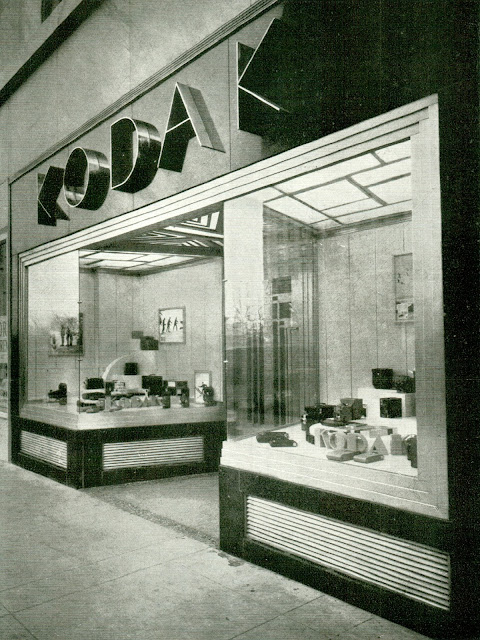 |
| EASTMAN KODAK SHOP NEW YORK CITY, N. Y. WALTER D. TEAGUE. Designer; R. B. SHERBOURNE, Associate |
COLOR: The entire design was conceived as providing a neutral setting for the display of the photographic enlargements and the various colorful objects of Eastman Kodak manufacture. It was executed, therefore, in varying tones of silver, gray, and black. The finish of the various materials was chosen with the same object in view. The display space draws the eye because it is of a light, dull finish in contrast to the dark, polished enframement.
MATERIALS: The facia and window bases are of emerald-pearl granite, but appear almost black in comparison with the other materials. The lettering, the muntins in the window soffits, and the pattern over the entrance are of polished chrome plate. The window frames and settings, the doors, and the grilles in the window bases are of benedict nickel. The walls of the show windows are of wood, flush panelled and inlaid with vertical strips of polished chrome plate. They were lacquered white and then sprayed with a silver mist, giving a light, neutral gray background to the objects on display. The lighting is entirely from above, the soffits being units of frosted glass.
DESIGN: The display counters have been kept low, better to attract attention, and the objects are displayed on plain standards of a finish similar to that of the walls. The grilles in the window bases serve as air intakes for a system of conditioned ventilation, which furnishes cleaned, heated and humidified air to all parts of the store. Clips are used at the window corners as an aid to complete visibility instead of the usual frame, and ornament is confined to the entrance where it does not attract attention from the windows.
 |
| EASTMAN KODAK SHOP NEW YORK CITY, N. Y. WALTER D. TEAGUE. Designer; R. B. SHERBOURNE, Associate |
 |
| A DISPLAY WINDOW |
 |
| SECTION THROUGH ENTRANCE |
 |
| EASTMAN KODAK SHOP NEW YORK CITY, N. Y. WALTER D. TEAGUE. Designer; R. B. SHERBOURNE, Associate |
 |
| EASTMAN KODAK SHOP NEW YORK CITY, N. Y. WALTER D. TEAGUE. Designer; R. B. SHERBOURNE, Associate |
 |
| Looking from the entrance toward the rear of the store. A neutral setting for the display of merchandise has been developed here as well as on the exterior, the general color scheme being silver, silver gray, and black. The floor is composed of three tone gray and black terrazzo, laid in blocks to form an irregular pattern which is outlined by wide strips of benedict nickel. The walls are panelled in English hardwood of a light, silver gray tone. The wood is laid in flush panels to take advantage of the variation in the grain. Black formica is used as a baseboard and as an outline of the wall cases. The pilaster caps, the cornice, and the moldings are of unpolished chrome plate. |
 |
| CINE-KODAK ROOM |
 |
| DETAIL OF WALL CASE |
Walter Dorwin Teague (1883 - 1960) is considered one of the founding fathers of industrial design as well as one of the most prolific American industrial designers in history. He established his design office in the late 1920s, which continues today as one of the important design institutions in the world. His most notable design work includes Kodak cameras from 1927 to 1957, Texaco’s art deco gas stations in the 1940s, the Boeing Stratocruiser, and the 707 aircraft.
The Eastman Kodak Shop at Madison Avenue and Forty-fifth street is no longer in operation.



The Apple Store of 1931.
ReplyDelete